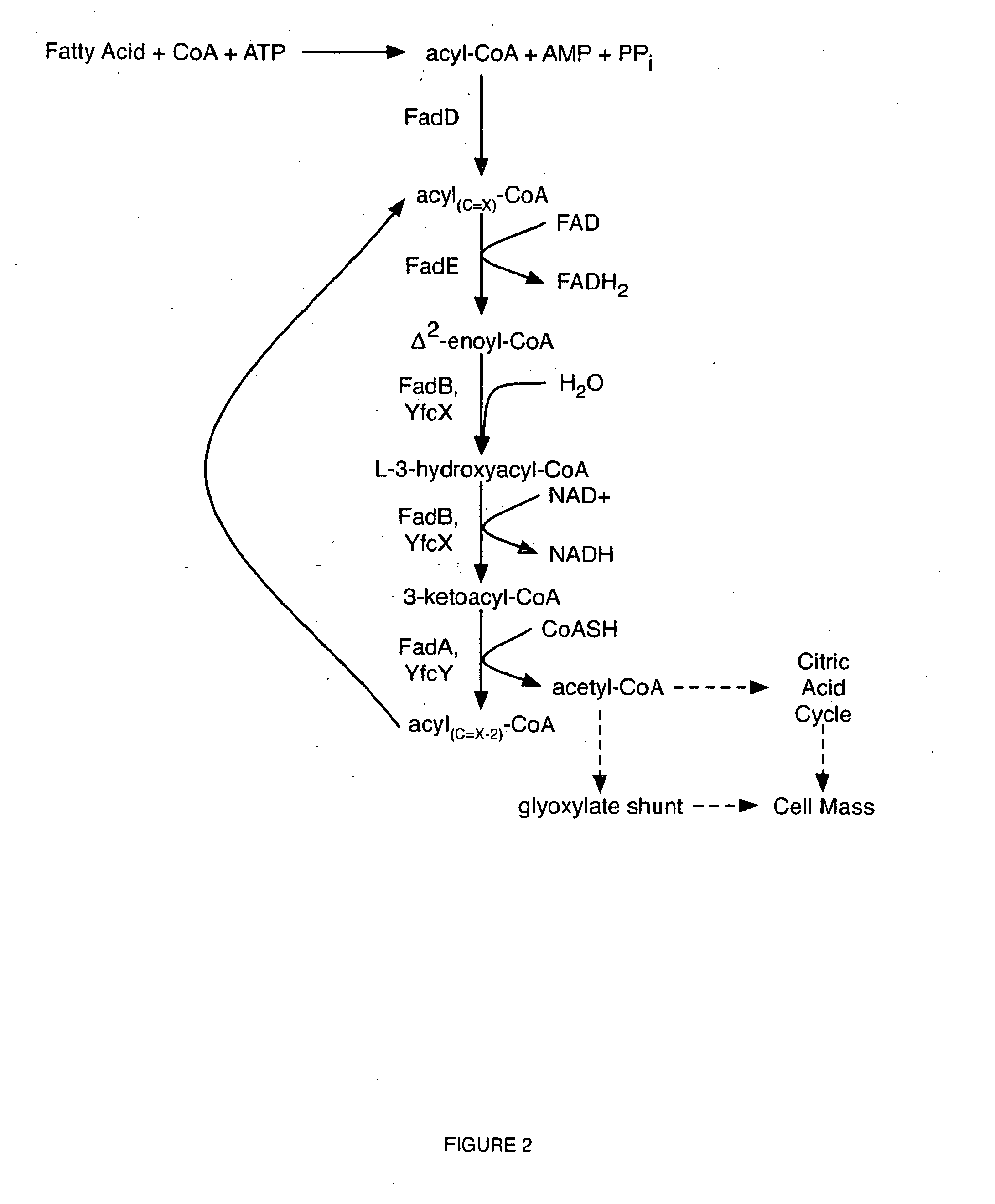[0045]The present disclosure therefore provides a method of converting fatty acids to 1,2-
propanediol, comprising culturing a
microorganism comprising, reduced fadR expression or function, or increased expression of the fad
regulon, increased expression of the atoDAEB genes, increased acetyl-CoA
acetyltransferase expression or function, increased acetoacetyl-
CoA transferase expression or function, increased acetoacetate decarboxylase expression or function, and a
gene encoding an acetol
monooxygenase and a gene encoding a
glycerol dehydrogenase, or a gene encoding an acetol
monooxygenase; a gene encoding an acetol
kinase; a gene encoding an L-1,2-
propanediol-1-
phosphate dehydrogenase; and, a gene encoding a
glycerol-1-
phosphate phosphatase, in a culture medium comprising free fatty acids, monoglycerides, diglycerides, triglycerides, phospholipids, or a combination thereof, thereby converting said free fatty acids to 1,2-propanediol.
[0049]The present disclosure also provides a method of producing
butyrate, comprising culturing a
microorganism comprising reduced fadR expression or function, or increased expression of the fad
regulon, increased expression of the atoDAEB genes, increased acetyl-CoA
acetyltransferase expression or function, increased 3-hydroxybutyryl-CoA
dehydrogenase expression or function, increased crotonase expression or function, a gene encoding butyryl-CoA dehydrogenase, and increased acetyl-CoA:acetoacetyl-
CoA transferase or
butyrate-acetoacetate
CoA transferase expression or function, or a gene encoding phosphotransbutyrylase and a gene encoding butyrate
kinase, in a culture medium comprising free fatty acids, monoglycerides, diglycerides, triglycerides, phospholipids, or a combination thereof, thereby producing butyrate.
Recovery of butyrate can be accomplished by standard techniques known to those of skill in the art, including, but not limited to,
recovery from the
fermentation broth by
ion exchange,
crystallization, or
precipitation.
[0057]In a further embodiment, the microorganism further comprises a gene overexpressing an
acetaldehyde dehydrogenase, and genes encoding the regulatory and catalytic subunits of
ethanolamine ammonia-
lyase. The high value chemical produced by the microorganism is
ethanolamine. The present disclosure thus provides a microorganism comprising reduced fadR expression or function, or increased expression of the fad
regulon, increased expression of the atoDAEB genes, increased
acetaldehyde dehydrogenase expression or function, and genes encoding the regulatory and catalytic subunits of ethanolamine
ammonia-
lyase. In certain embodiments, the microorganism comprises an endogenous or
heterologous acetaldehyde dehydrogenase. In particular embodiments, the acetaldehyde dehydrogenase is the mhpF gene from E. coli. In other embodiments, the regulatory
subunit of ethanolamine
ammonia-
lyase is the eutB gene and the catalytic
subunit of ethanolamine ammonia-lyase is the eutC gene.
[0060]Thus, the present disclosure provides a microorganism comprising reduced fadR expression or function, or increased expression of the fad regulon, increased expression of the atoDAEB genes, and one or more of the following: (1) a
nucleic acid sequence encoding an
alcohol dehydrogenase
protein that is active under aerobic conditions; (2) increased expression of an
acetate kinase gene; (3) increased expression of a
phosphate acetyltransferase gene; (4) increased expression of an ADP-forming acetyl-CoA
synthetase activity; (5) expression of an acetyl-CoA
synthetase activity that functions primarily to produce acetate from acetyl-CoA; (6) reduced sucA expression or function; (7) reduced sucB expression or function; (8) reduced sdhA expression or function ; (9) reduced sdhB expression or function; (10) increased expression or function of succinic semialdehyde dehydrogenase; (11) increased expression or function of succinyl-CoA:CoA
transferase; (12) increased expression or function of succinate-CoA ligase; (13) increased gamma-
hydroxybutyric acid dehydrogenase expression or function; (14) increased
lactonase expression or function; (15) increased
aldehyde dehydrogenase expression or function; (16) increased
alcohol dehydrogenase expression or function; (17) increased methylmalonyl-CoA
mutase expression or function; (18) increased methylmalonyl-CoA decarboxylase expression or function; (19) increased propionyl-CoA:succinate CoA
transferase expression or function; (20) increased acetyl-CoA acetyltransferase expression or function; (21) increased acetoacetyl-CoA
transferase expression or function; (22) increased acetoacetate decarboxylase expression or function; (23) a gene encoding an
acetone monooxygenase; (24) a gene encoding secondary
alcohol dehydrogenase; (25) a gene encoding an acetol monooxygenase; (26) a gene encoding a
glycerol dehydrogenase; (27) a gene encoding an acetol
kinase; (28) a gene encoding an L-1,2-propanediol-1-phosphate dehydrogenase; (29) a gene encoding a glycerol-1-phosphate
phosphatase; (30) increased 3-hydroxybutyryl-CoA dehydrogenase expression or function; (31) increased crotonase expression or function; (32) a gene encoding butyryl-CoA dehydrogenase; (33) increased acetyl-CoA:acetoacetyl-CoA transferase expression or function; (34) increased butyrate-acetoacetate CoA transferase expression or function; (35) a gene encoding phosphotransbutyrylase; (36) a gene encoding butyrate kinase; (37) a gene encoding
butyraldehyde dehydrogenase; (38) a gene encoding
butanol dehydrogenase; (39) a gene encoding 3-hydroxy-3-methylglutaryl-CoA synthase; (40) a gene encoding 3-hydroxy-3-methylglutaryl-CoA
reductase; (41) increased acetaldehyde dehydrogenase expression or function; (42) a gene encoding the regulatory
subunit of ethanolamine ammonia-lyase; (43) a gene encoding the catalytic subunit of ethanolamine ammonia-lyase; (44) reduced NADH dehydrogenase expression or activity; (45) a
nucleic acid sequence encoding a fadE
protein that uses NAD+ or NADP+ as a co-factor; (46) reduced iclR expression or function; (47) increased expression of an aceA gene; or (48) increased expression of an aceB gene.
 Login to View More
Login to View More 









